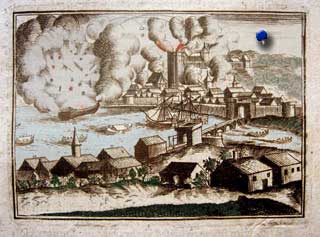Varin Family.
Origins in Dieppe, Normandie.
Nicolas Varin married Jeanne de Lacroix on 15 September 1653 in Saint-Jacques church in Dieppe. She was the daughter of Nicolas de Lacroix.
The important harbor town they lived in was built where the Arques, fed by three other rivers, emptied into a basin before draining into la Manche, or English Channel. Scallops were abundant in the confluence of the waterways.
An ancient castle rebuilt in the 15th century stands on the western precipice overlooking the town. The premier port launched many voyagers across the seas and its school of cartography was among the best in France in the 16th century.

Nicolas and Jeanne had six children including our ancestor Nicolas who would would himself venture across the ocean to settle in a distant land.
The town was heavily shelled as the combined Anglo-Dutch navy sailed up la Manche after attacking the town of Le Havre in 1694. Whether this inspired his enlistment is unknown (he was already 29), but our ancestor Nicolas (the son) soon was found among the Troupes de la Marine.
New France.
Jean-Baptiste Colbert, Marquis de Seignelay desired a branch of service that would be toujours prêt à embarquer {always ready to embark}. These companies of the marine were under the Secretary of the Navy and guarded the major ports of France. It was Cardinal Richelieu who ordered them to serve aboard ships and then Louis XIV sent them to New France in 1683 to replace the regular troops he was withdrawing for other fronts. They were charged with protecting the larger towns and the fur trading centers. Our ancestor Clément Lériger was among those who arrived in 1685. Though the Marines had the same training in traditional warfare as the regular troops, they too adapted their strategy to la petite guerre {guerrilla warfare} that was far more effective in these lands.
Nicolas Varin arrived in Longueuil, New France with the military sometime before 1697. The settlement had been founded by Charles Le Moyne, a fellow Dieppois in 1672 who named it after a small village near Dieppe. Charles' son of the same name built his residence around 1685 that doubled as a stone fort. Another of his sons, Pierre Le Moyne d'Iberville, was a member of the Marines commanding the flagship Pélican in the Battle of Hudson's Bay against the English. Though his ship was lost the battle was won in September 1697.
Like many in the military, Nicolas adopted a dit name (alias). His was la pistole. It was what the French called the Spanish gold coin and later the nickname given to the Louis d'or, France's gold coin named for its Kings.
Marriage to a Canadienne.
Marie-Anne Ronceray and Nicolas Varin dit Lapistole were married in Boucherville on 29 October 1697. Though he continued to serve in Longueuil's company he was a tradesman which was a bit unusual for a soldier. Nicolas was a maître tonnelier {master cooper}. Coopers built casks. A "master" typically had others working for them.
The couple's first few children were born in Longueuil, including our ancestor, another Nicolas. Six of their twelve children died at early ages. The family moved to Montréal when their son was just a toddler where the father honed his trade.
His sons Jacques, Nicolas and Louis-Joseph all became wet coopers as well. Their skill was such that they could build casks tight enough to hold liquids including water, wine, and brandy.
Nicolas died in Montréal on 23 May 1737 at the age of 71. Marie-Anne Ronceray was 58 when she died 8 April of the previous year.
- Fichier Origine: MAUDOU / MONDOU / POITEVIN, Aubin 242834
- André Marois, A History of France, Alden Press:Oxford, 1964, p170-171
- Jetté, René, Dictionnaire généalogique des familles du Quebec des origines à 1730 (Montréal: Les Presses de l'Université de Montréal, 1983)
- https://www.map-france.com/Requeil-72510/
- https://web.archive.org/web/20060623033343/http://dlf49.com:80/text/histoire/histoire_en.php
